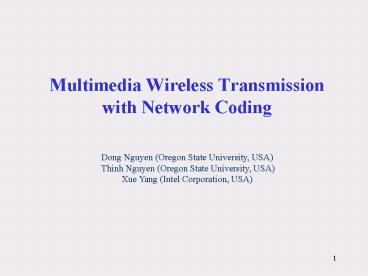Multimedia Wireless Transmission with Network Coding PowerPoint PPT Presentation
1 / 29
Title: Multimedia Wireless Transmission with Network Coding
1
Multimedia Wireless Transmission with Network
Coding
Dong Nguyen (Oregon State University, USA)
Thinh Nguyen (Oregon State University, USA)Xue
Yang (Intel Corporation, USA)
2
Contents
- Multimedia Wireless Transmissions
- Network Coding
- Markov Decision Process
- Algorithms
- Conclusion
3
Multimedia Wireless Transmissions
- Multimedia wireless transmission is very common
- TV networks
- Wireless Sensor Networks
- Wireless LAN, WiMAX
- Problem statement How to send multimedia data
over a lossy wireless environment to minimize
total distortion
4
Multimedia Wireless Transmissions
- Wireless Transmissions
- One transmission can a packet send to many
receivers
- Multimedia data transmissions
- Dependences among packets
Multimedia signal
Segmentation (Framing)
R1
R2
Frames
R3
S
Layered Encoder
R4
R6
R5
Dependent packets
Network coding combine packets before sending
Decision Making Which order of packets to
transmit?
5
Network Coding
- What is the capacity of a network?
S
a
S
b
a
b
M
N
b
a
M
N
b
a
O
Congestion
O
b
a
a?b
a
b
a?b
P
a?b
P
T1
T2
T1
T2
ba?(a?b)
ab?(a?b)
Network Coding
Store and Forward
6
Wireless Network Coding
- Wireless information exchange
a
a
b
b
a?b
a?b
b
3
3
b
4
R2
b
R2
R1
R
R
R1
a
b
a
a
1
2
1
2
ba?(a?b)
ab?(a?b)
- Store and forward approach
- 4 transmissions
- Network coding approach
- 3 transmissions
Gaining 4/3
7
Wireless Network Coding
Sending 4 packets a1, a2, a3, and a4 from node S
to two receivers A and B
A
lossy channel
S
a4
a1
a2
a3
lossy channel
B
Feedback (ACK, NAK)
Two approaches 1) Retransmission Auto Repeat
Request (ARQ) 2) Network Coding Encode at the
source, decode at the receivers
8
Wireless Network Coding
Traditional Approach
- Lost packets a2 and a4 are retransmitted
- 6 transmissions required
9
Wireless Network Coding
Network Coding Approach
- Network Coding combine a disjoint pair of lost
packets and retransmit it. - 5 transmissions required gaining 5/6
10
Multimedia Wireless Transmissions
Transmission policy
Transmission buffer
Lossy channels
R1
Layered Encoder
R2
Frames
RN
Packets
Packets
feedback (instantaneous)
Transmission of multimedia packets to multiple
receivers
11
Multimedia Wireless Transmissions
Lossy channels
Transmission policy
buffer
R1
1) Retransmission 2) Network Coding 3) Decision
making technique
R2
RN
Packets
feedback (instantaneous)
Three components of transmission policy
12
Multimedia Wireless Transmissions
- Decision making problem
- Packets are dependent and different packets have
different importance - Which order of packets to send to minimize
distortion under lossy channels and limited
transmission time? - Decision making technique Markov Decision
Processes
13
Markov Decision Processes Example
Two-state Markov Chain and Reward
0.57
1
2
0.5-9
0.38
0.75
0.5-9 Transition probability is 0.5, giving
reward -9
- Each transition yields a reward
- Total expected reward after N transitions is
deterministic - Markov Decision Processes there is a set of
actions to control transition probabilities
14
Markov Decision Processes Example
Two-state Markov Decision Processes
a2,2 0.46
a1,1 0.5-9
a2,2 0.6-6
a1,1 0.57
1
2
a1,2 12
a2,1 0.38
a2,1 0.38
a2,1 0.75
a1,2 0-11
Transition and reward matrices for action 1 and 2
15
Markov Decision Processes Definition
- Markov Decision Processes
- State space S
- Action space A
- Transition probabilities for each action P
- Reward R
- Discrete time transition Actions are taken and
state transitions happen at each time epoch - Goal Select action at each time epoch to
maximize the expected total reward after N time
epochs - Set of actions is called action policy
- Find the optimal policy
16
Markov Decision Processes a solution
- Backward Induction Algorithm
- Policy
- Sequence of states and actions
- Total Reward
17
Markov Decision Processes a solution
- Backward Induction Algorithm
- 1) Set
- 2) Substitute t-1 for t and compute reward for
each state by - 3) If t 1, stop. Otherwise return to step 2
18
Multimedia Wireless Transmissions
- State representation
indicate the presence of packet i at
receiver Rj
- Action representation
- Send packet li
- Send XOR packet
19
Multimedia Wireless Transmissions with Network
Coding
- Transition Probabilities compute
- for each state and action given error
probability at each receiver - Reward Compute reward returned from each state
transition based on each packets importance
20
Multimedia Wireless Transmissions with Network
Coding
- Example
- Sending 2 packets l1 and l2 to two receiver
- There are 16 states
- 3 actions
- Sending l1
- Sending l2
- Sending
- Figure Probability matrix of sending l1
21
Multimedia Wireless Transmissions with Network
Coding
- Example
- Reward matrix of sending l1
22
Multimedia Wireless Transmissions with Network
Coding
- Example
- Transition probability matrix of sending
23
Multimedia Wireless Transmissions with Network
Coding
- Example
- Reward matrix of sending
24
Multimedia Wireless Transmissions with Network
Coding
- Sending 2 streams Akiyo and Foreman to two
receiver R1 and R2 - Each video sequence has 3 enhancement layers 1,
2, and 3 - A common deadline is set for all sequences
- Rewards are measured in total reduction of
distortion - Two settings Broadcast and unicast
25
Multimedia Wireless Transmissions with Network
Coding
Two settings
- Broadcast
Unicast
26
Multimedia Wireless Transmissions with Network
Coding
- Simulation results Broadcast
27
Multimedia Wireless Transmissions with Network
Coding
- Simulation results Unicast
28
Conclusions
- Existing Issues
- State space and action space explode when
increasing number of receivers and number of
video sequence - Future works
- Solving problem with more number of receivers and
video sequences
29

